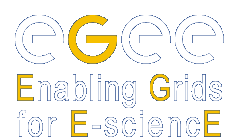Technical Information
High Energy Physics
The High-Energy Physics (HEP) community is one of the pilot application domains in EGEE, and is the largest user of its grid infrastructure. The four Large Hadron Collider (LHC) experiments (ALICE, ATLAS, CMS and LHCb) at CERN, Europe's central organisation for nuclear research have production which involves more than 150000 daily jobs o the EGEE infrastructure in collaboration with the OSG project in the USA and NDGF in the Nordic countries and generates hundres of terabytes of data per year. The first proton-proton collisions are expected in summer 2009.
By their nature HEP applications are very demanding. Because of this they serve a powerful role in understanding and improving EGEE delivered services. The HEP experiments also produce high-level middleware components than often become valuable prototypes for the overall grid community. The expertise developed by HEP users is open to the other EGEE grid users. This kind of applications are an important driving force within the EGEE project and promotes progress across many scientific disciplines.
Towards a real data taking regime: the CCRC'08 exercise
In preparation for real data taking, the four LHC experiments performed in 2008 a large scale exercise called Common Computing Readiness Challenge 2008 (CCRC'08). For the first time, the four experiments stressed both their own computational models and the grid infrastructure at once.
Large and realistic productions using real data recorded by cosmic rays have been performed putting all grid elements and services together and simulating what the experiments will face in real conditions. The full exercise also stressed the service, support and operation protocols and procedures defined by the grid team towards an efficient data taking approach. This exercise, which is planned to be repeated every year during the scheduled machine shutdown, can be used by any other community as experience and guide to set their own grid infrastructure towards a stable production regime.
Further grid projects at CERN
CERN also supports other research communities whose fields are not fully related to HEP; from humanitarian projects as UNOSAT, passing through worldwide telecommunication setups (ITU), until multipurpose simulation tools as Geant4. theoretical physics applications (Lattice QCD studies) and beam tracking and collimation studies of the LHC.
A set of tools have been developed at CERN with the HEP support team which help the grid work in a more effective and user-friendly way. These tools, developed to assist the HEP community, have been successfully exported to other communities as gridification tools used by a large number of research fields:
- Ganga: used to submit to a large number of distributed computing environments including Grid resources with the same interface
- Diane: used to optimize the usage of the available resources
- AMGA: the metadata catalogue
- Dashboard: a standard and general monitoring tool of the user jobs and the resources status
Non-LHC HEP applications
Other major HEP experiments, such as BaBar, CDF, DO, H1 and ZEUS have also adopted grid technologies and use the EGEE infrastructure for routine physics data processing.


